Philips Hue parent company Signify debuted a new version of the Hue Festavia string lights back in August, with plenty of availability now that the holidays are approaching. If you're up to date with Hue, you might know that the Festavia first came out last year, but the first version was available in limited quantities and was hard to get.
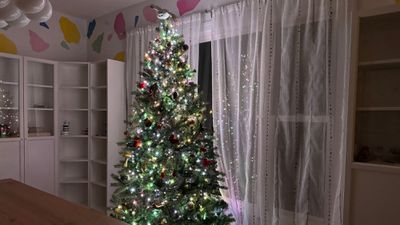
After the holidays, the Festavia lights seemed to disappear entirely until the new version came out in this year, and that's because this is a new model. The new Festavia lights and the old Festavia lights are similar in design, but there are tweaks to the sizes of the light strings, the price, weatherproofing, the design of the power supply, and a few other features.
Last year's Festavia lights were priced at $160 for 250 LEDs on a 65-foot strand, and this year, the same 65-foot strand with 250 LEDs is priced at $220. I don't know why the lights are priced higher, but there are two new size options, including a 500-LED 131-foot model and a 100-LED 26-foot model. The Hue website sells the two longer strands right now, but not the shorter version.
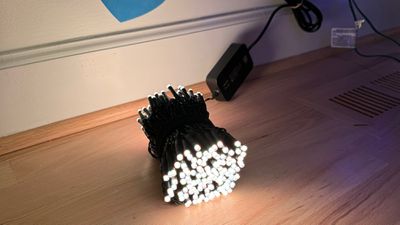
I tested the 250 LED model, which has the LEDs positioned about three inches apart on the strand. The lights themselves are flat at the top with a circular body, which is the same design that was used last year and the shape you'll also see in smart lights from brands like Twinkly. The cord connecting the LEDs is black, which is one of my complaints about the Hue lights.
Black does not blend in as well with a tree as green does when used on a typical Christmas tree, and I feel that it makes the cord stand out more than it should. It would be nice to have color options for the wires rather than being limited to black. Even in non-tree use, black stands out on white trim or white walls. Nanoleaf and Twinkly are using the same black cord for their lights, so maybe it's a color most people don't mind.
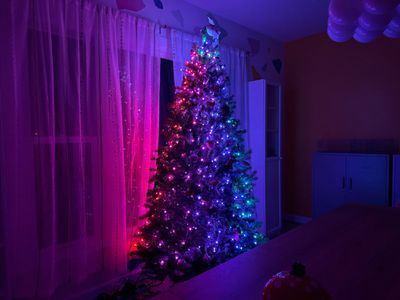
Last year's Festavia lights were designed to be used indoors, but this year's version has weatherproofing and can be used indoors or out. You can use these outside on your porch, outdoor trees, around windows, on eaves, and more, so you're not just limited to inside use. I wouldn't put lights this expensive outside, but I appreciate the versatility for those who do want to use them for outdoor landscaping purposes.
Other than the new weatherproofing rating, the only other difference between the 2022 Festavia and the 2023 Festavia that I found was the design of the power supply. The 2023 version has a 30W plug that you can unscrew from the controller so you can use the Festavia outdoors with other outdoor power you might have.
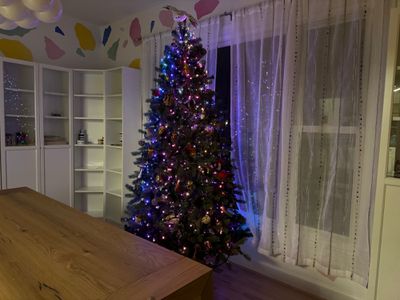
With traditional holiday lights, you can connect two or more strands together to run off of the same power supply, but that is not an option here. Every strand has its own dedicated power supply and these are bulky, especially when used indoors. I put two strands on my tree, and it's a lot of cabling hefty power supplies to deal with. For a Christmas tree that's about seven feet tall, I can get away with one strand, but two strands covers the front and back more fully at a better density. I wish there was an option for a 65-foot strand with a higher LED density, because 65 feet is the right length for a standard tree, but a single strand doesn't feel like quite enough due to the spacing.
These are low voltage LEDs that don't get warm, so you can use them just about anywhere without worrying about a fire hazard. Since these are string lights meant for holiday decorating, there is a warning in the box that suggests you can only leave them up for 90 days. It's a warning that is required under the UL standard used for this type of light because of the testing parameters used for them. I have kept the prior-generation Festavia lights up for a much longer period of time without issue because I am not packing away such expensive lights for most of the year, but it's something to pay attention to.
Like all Hue lights, the Hue Festavia is controlled through the Hue app. It supports 16 million colors and multiple shades of white as it is a "White and Color Ambiance" product, plus it is a gradient light so the colors blend into one another. The Festavia lights can be used directly in the Hue app over Bluetooth, but it's a better experience if you have a Hue Bridge. A Bridge allows for control away from home, connectivity over Wi-Fi, and of course integration with other Hue products.
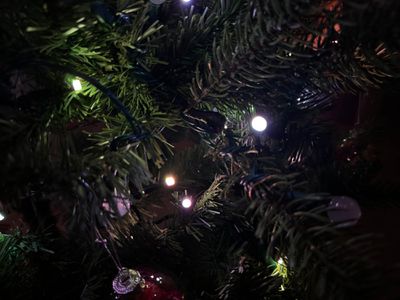
With the Hue app, there are a lot of options for color schemes. There are three total zones for each strand of lights, and you can set each one to a separate color on the color wheel to use the gradient effect. Scenes can be created and saved, and the lights work with all of the scenes in the Hue scene gallery for pre-set color arrangements.
There are six special effects available too, including candle, fireplace, sparkle, glisten, opal, and prism. Candle and fireplace are self-explanatory and aren't really designed for this kind of string light. Candle looks okay with just the flickering yellow lights, but fireplace is much oranger and looks out of place.
The other four options are perfect for the Festavia. Sparkle is a white/yellow light scheme that looks like slow twinkling lights. Glisten is similar to sparkle but with more "twinkle," and opal, which looks like its namesake, is by far my favorite. Opal uses soft, pastel lights that are just shy of white and it cycles through them for a soft, but colorful effect that looks something like the lighting equivalent of a nighttime winter snowfall. It's one of the most magical lighting effects I've seen from smart lights.
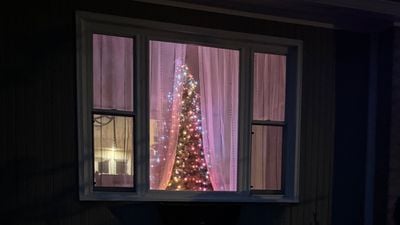
Prism is a slow rainbow gradient that's also quite striking, with the colors shifting so slowly that it's not at all distracting and is even hard to notice if you're not directly paying attention. It's a truly pretty gradient that doesn't overwhelm a room. Cameras have a hard time with string lights, so while I did my best to capture photos and videos, the Festavia looks better in real life. All of these lighting options work with both versions of the Hue Festavia, so there's nothing exclusive to the second-generation release. Opal and glisten are effects that are only compatible with the Festavia, while candle, fireplace, and prism work on some of the other Hue lights.
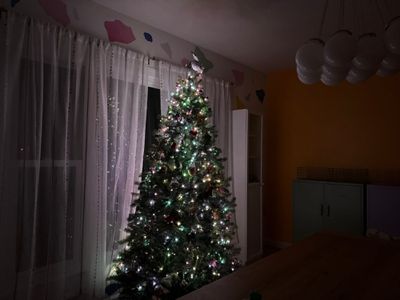
It is worth noting that the Festavia lights do not get as bright as the Twinkly smart lights, nor do they do the intricate patterns and rhythms that are available with other brands. I find the brightness of the Philips Hue lights to be optimal, and when I use Twinkly lights, I never have them above 50 percent brightness because they're too bright to look at.
Twinkly lights are what I'd want to use for a raucous ugly sweater type of party, while Hue lights are what I'd use for a holiday dinner party. Hue lights are more subtle and have a more elegant, cozy vibe that I think most people will prefer. A major exception is families with children, because the Twinkly app is arguably more fun. You can change each LED to a different color with Twinkly, and that's not possible with Hue. Hue also doesn't support different animation patterns and speeds, so you can't set the lights to do things like blink on and off.
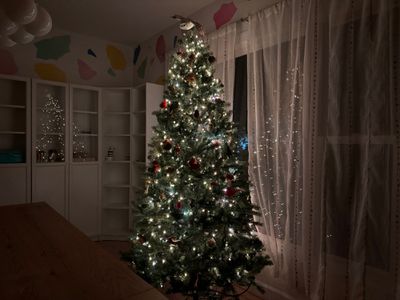
You're supposed to put the Festavia lights on the tree in a certain way (there are instructions on the Hue website), wrapping them from the bottom up in rows that are spaced six inches apart and matching up gradients if you're using two strands. I used that method with the lights last year, but this year I broke the rules and hung my lights vertically. I'm a fan of the vertical look, but it would be nice if the Hue app had a feature like the Twinkly app that let you tell the lights where they were rather than having to hang them in a particular way. Side note, the internet told me to hang lights vertically to make them easier to remove from a tree, but I had to tuck them so far back to hide the black cord that I'm not sure vertical was beneficial.
If you have other Hue lights, you can integrate the Festavia with them. In the room where I have my tree, I have a hanging lamp with multiple Hue bulbs, so the tree and the bulbs can all be color coordinated. Festavia lights can also be included in an Entertainment Area to match lighting to TV content or music. You'll need a Hue Play HDMI Sync Box, a compatible Samsung TV, or a Spotify account to make this work.
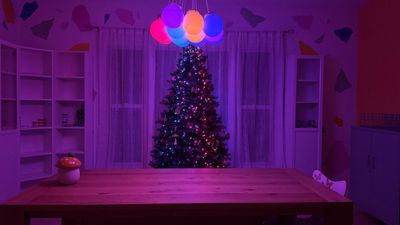
The Hue Festavia lights work like any other Hue light in terms of control and automation. You can set up automations to turn them on and off, to change the colors at certain times, or to trigger with motion or other parameters. They can be controlled in the Hue app, in the Home app, and with Siri voice commands.
Bottom Line
The Philips Hue Festavia lights are ideal for people who already have Hue lights. If you're entrenched in the Hue ecosystem, you likely won't be too surprised at what Signify is charging for these. A 250-LED strand of standard holiday lights is around $20, and Twinkly charges about $150 for a similar smart version, so the Festavia lights definitely have a premium price tag.
There is no substitute for the aesthetic of the Festavia, the ease of use, or the integration with Hue bulbs, though. Other smart lights seem almost garish in comparison to the soft, ethereal look you can get from the Festavia. I have a mild obsession with lamps, string lights, light strips, and bulbs, so I have tried a lot of the options out there and with Hue, I have few complaints aside from the cost.
Hue products integrate seamlessly with HomeKit and the Zigbee Bridge means that everything just works. For context, I have more than 50 Hue lights (that I bought) because I've learned that Hue just doesn't give me trouble. I hate HomeKit troubleshooting because of the lack of transparency from Apple, so I pay more upfront to not have to spend 30 minutes trying to figure out why a light has disconnected itself from HomeKit and won't reconnect.
If you don't have Hue lights and don't plan to buy any, I don't think this is the best pick because you're missing out on the integration, but you'll still get the benefits of the Hue colors and scenes. Twinkly and Nanoleaf make for better one-off purchases, with Twinkly in particular offering fun effects and controls that children will enjoy.
How to Buy
The Philips Hue Festavia String Lights can be purchased from the Hue website for $220.
Note: Signify provided MacRumors with a 250-LED Festavia for the purpose of this review. No other compensation was received.






















Top Rated Comments
Still waiting for an app that let's you backup and restore the bridge with all the lights.
Still waiting for an app/system that seamlessly merges multiple bridges.
How do we beat the algorithm? Stop buying **** we don't need and/or can't afford. And give what you can to those who need it far more than we do. Then maybe, prices will come down.